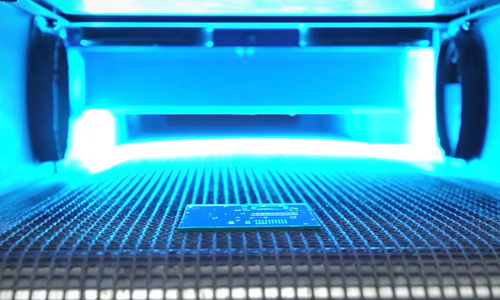Sauerstoffhemmung in UV-Klebstoffe
F: In der Vergangenheit haben wir bei einigen lichthärtenden aushärtbare Klebstoffe eine Art Hemmung festgestellt, die Rückstände auf der Oberfläche hinterlassen hat. Was verursacht dieses Phänomen und wie können wir es vermeiden?
Dieses Phänomen wird als Sauerstoffinhibition bezeichnet und seine Abschwächung hängt von mehreren Faktoren ab:
- Erzeugte Intensität über das UV-Spektrum (280-390 nm)
- Expositionszeit
- Die vom UV-Härtungssystem erzeugte Wärme
- Die spezielle Formulierung des Klebstoffs
aushärtbare Klebstoffe härten aus, wenn ihre Photoinitiatoren Licht unterschiedlicher Wellenlängen ausgesetzt werden, wodurch die Photoinitiatoren in Radikale zerlegt werden. Diese Radikale reagieren dann mit den Klebstoffoligomeren und bilden lange Ketten und Vernetzungen. (Wenn Sie Licht auf den Klebstoff richten, wird er fest.)
Normalerweise durch die Wahl eines hochintensiven Lichts von >1 W/cm 2 / 1.000 mW/cm 2 und über einen breiten Spektrumbereich von 280–450 nm zum Aushärten von UV-Klebstoffe. Dabei ist so viel Energie vorhanden, dass die Klebstoffe extrem schnell vernetzen und eine feste, klebrigkeitsfreie Oberfläche hinterlassen.
Einige Monomere und Oligomere, die Bausteine lichthärtender aushärtbare Klebstoffe, können während der Aushärtung anfällig für Sauerstoffhemmung sein. Dieses Phänomen tritt während des Aushärtungsschritts auf, und wenn Sauerstoff vorhanden ist, kann er in die Oberfläche eindringen und die radikalische Polymerisation stören, wobei teilweise umgesetzte Monomere und Oligomere zurückbleiben. Das Ergebnis ist das klebrige Gefühl, das manche Menschen verspüren, wenn sie mit dem Finger über die Oberfläche eines Klebstoffs reiben, oder die Spuren von feuchten Rückständen auf ihrer behandschuhten Hand.
Um die Sauerstoffhemmung zu verringern, hängt die Aushärtung eines lichthärtenden aushärtbarer Klebstoff zu einem „glatten und trockenen Finish“ oder einer klebefreien Oberfläche von der Zusammensetzung des Materials sowie der Intensität und Wellenlänge des verwendeten Lichts ab. Es wurde nachgewiesen, dass die Oberflächenbeschaffenheit umso besser ist, je höher die Intensität des UV-Lichts ist.
Normalerweise erreicht UV-Licht mit kurzer und mittlerer Wellenlänge (280–320 nm), das von Quecksilberdampflampen erzeugt wird, eine effizientere Oberflächenhärtung, hat aber Probleme mit der Aushärtungstiefe. Systeme mit längerer Wellenlänge (400–500 nm) strahlen normalerweise einen kleinen Anteil UV-Licht in den niedrigeren Wellenlängen ab und haben eine bessere Aushärtungstiefe. Das UV-/sichtbares Licht im Bereich von 320–450 nm scheint die beste Mischung aus Oberflächen- und Tiefenhärtung zu bieten.
Durch Veränderung des Aushärtungsprozesses mit höherer Lichtintensität, längerer Aushärtungszeit oder leichter Anpassung der Lichtwellenlänge kann die Oberflächenklebrigkeit beseitigt werden. Einige UV-Klebstoffe härten selbst mit diesen Veränderungen nie klebfrei aus, da sie für Anwendungen ohne Lufteinwirkung, wie z. B. Klebung zwischen zwei Substraten, konzipiert sind.
*Die Zeit zum Aushärten eines lichthärtenden aushärtbarer Klebstoff bis zum klebfreien Zustand darf nicht mit der Zeit zum Erreichen einer vollständigen Aushärtung verwechselt werden. Sie gibt lediglich die Fähigkeit des Materials an, die Sauerstoffhemmung an seiner Oberfläche zu überwinden, nachdem es für eine bestimmte Zeit einer bestimmten Lichtintensität ausgesetzt wurde.
Daher müssen Benutzer die Intensität der von ihnen verwendeten Härtungslampen berücksichtigen.
Lampen mit höherer Intensität können enorme Intensitäten erzeugen, gemessen in W/cm 2 Einige Spotlampensysteme emittieren beispielsweise bis zu 15-20 Watt/cm 2 (gemessen bei 365 nm). Mit einem Hochintensitäts-Lichthärtungssystem, das sowohl UV- als auch sichtbares Licht aussendet, können die meisten Klebstoffe relativ einfach klebfrei ausgehärtet werden.
Wir haben festgestellt, dass die meisten Klebstoffe eine Mindestintensitätsschwelle aufweisen, bei der sie innerhalb einer bestimmten Zeit klebfrei werden, sowie eine Mindestgesamtenergieschwelle, um vollständig auszuhärten.
Betrachten Sie die Gleichung „Watt/cm 2 x Sekunden = Joule/cm 2 ". Sie können die Intensität in Watt gegenüber der Belichtungszeit in Sekunden variieren, um die gleiche Menge an Joule/cm zu erhalten 2 :
2 Joule/cm 2 = 2 Watt/cm 2 x 1 Sekunde oder 2 Joule/cm 2 = 0,02 Watt/cm 2 x 100 Sekunden.
Sie erhalten in beiden Situationen die gleiche Gesamtenergie (hohe Intensität für kurze Zeit oder niedrige Intensität für lange Zeit), aber Sie fallen möglicherweise unter die Mindestintensitätsschwelle von 0,1 Watt/cm 2 – Sie erhalten also nie eine klebefreie Oberfläche.
Manchmal ist es sinnvoll, das Problem der Sauerstoffhemmung anders zu lösen und den Aushärtungsbereich während der Aushärtung mit Stickstoff oder Argon (Inertgas) zu fluten. Das Inertgas verdrängt den Sauerstoff an der Oberfläche und sorgt so für eine klebefreie Oberfläche, selbst bei Lichtquellen mit geringer Intensität.
Die Sauerstoffhemmung in lichthärtenden Materialien kann durch die Wahl des richtigen Klebstoffs, Verfahrens, der richtigen Lichtwellenlänge, Belichtungszeit und Lampenintensität gemildert werden.

